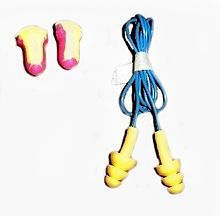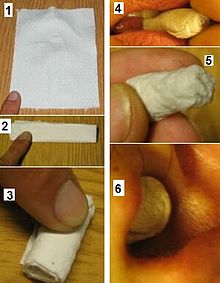ear protection
When hearing protection all kinds of be guards or protective equipment referred to the hearing before too loud noises protect and acoustic trauma prevention.
Areas of application
In an environment with a high noise level, such as when working near noisy machines (airports, road construction, industrial machines, etc.), it has been mandatory to wear hearing protection at the workplace since February 2006 from 85 dB (A) . It is also required that suitable hearing protection is available on the part of the employer from 80 dB (A). Even at music events of all kinds (concerts, discos, festivals, parades, etc.) this sound pressure level is often exceeded by far. For all types of events, the EU directive applies to employees, DIN 15905-5 applies to the permissible volume to which the audience may be exposed, and the advice to take hearing protection into your own hands.
Other areas of application:
making music with loud instruments (drums, whistles, recorder heads, ratchets, etc.), when traveling in loud means of transport (train, bus, car, plane, motorcycle), with snoring bed neighbors or other environmental noises that disturb sleep, New Year's Eve, carnival, shooting sports, Motorsport events and Ä.
Evaluation of the attenuation value of hearing protection
The attenuation of hearing protection is a maximum of around 25–40 dB, although it is ultimately highly dependent on frequency, material and anatomy. In order to achieve higher insulation values, a hearing protection system worn in the ear (otoplastic or plug) can be combined with earmuffs.
The hearing protectors approved according to a test standard for occupational safety are always brought onto the market with information on their insulation behavior ( HML values ). For a simplified comparison of different products, an attenuation value is given which indicates the averaged attenuation over the relevant frequency range and is therefore only useful for approximate orientation and for simple comparison of different attenuation means. The condition and use of hearing protection have a decisive influence on its effectiveness in an emergency. Different damping means also differ considerably in terms of their effect at different frequencies.
In practice, a deduction is made from the specified attenuation value for safety reasons. This deduction is for:
- Plug −9 dB
- Capsules −5 dB
- Earmolds −3 dB
Legal requirements for hearing protection
Hearing protection for visitors to events is regulated by the permissible volume level in DIN 15905-5. In Germany, the audience is allowed to an average level of max. 99 dB A exposed.
These are often not adhered to. In recent years, various organizers have been sentenced to pay compensation for non-compliance with the level when hearing damage has occurred.
According to the regulations of the accident insurance institutions, plugs and capsules are considered to be equivalent when selecting hearing protection. From 80 dB (A), ear protection is recommended at the workplace, from 85 dB (A) it is mandatory.
Legal regulations and further information on hearing protection are available in the free hearing protection web app. All information can be called up across all documents and accessed via an index.
Types of hearing protection
Earmuffs
Ear defenders are particularly useful for short-term use (e.g. in building construction) . These are closed, headphone-like , circumaural capsules that can be easily put on and taken off at any time. The ear is at such equipment completely of a hard plastic shell-enclosed, the padded at the contact point and otherwise of sound-absorbing and polsterndem foam lined. They are available in a version with a headband, neckband and universal hook that can be worn over the head as well as behind the neck. When wearing the neck, the universal hanger is also provided with a headband for better fixation of the hearing protection. According to the classification of the German Social Accident Insurance, this type of earmuffs belongs to the "conventional earmuffs".
Another type of "special earmuffs" is the so-called active earmuffs. This is equipped with level-dependent insulation for active noise compensation and can be supplemented with a radio communication device or an integrated VHF radio. With level-dependent attenuation, a microphone is attached to the outside of the hearing protection capsule , which picks up ambient noise, processes it via a small amplifier and outputs it inside the capsule via a small loudspeaker. The amplifier has a built-in, very fast control that only processes noises up to a certain volume level (in Germany 85 dB (A)) (peak clipping (PC), automatic gain control (AGC). A loud bang, for example, is effectively attenuated by this ; Conversations are still possible. This system is used, for example, at police shooting ranges when teaching practical weapons or also during hunting, where the hunter depends on the acoustic perception of the environment. In earmuffs with communication equipment, a loudspeaker is built into the capsule so that instructions and other messages, e.g. via a cable or a radio device, can be understood despite hearing protection and outside noise. The wearer can also be given the opportunity to speak himself via a microphone attached to a bracket in principle the same structure, but they contain a VHF -Receiver. In both types, the loudspeaker levels are limited to 82 dB (A).
"Earmuffs in combination with other personal protective equipment" are z. B. intended for attachment to protective helmets and form the third type of earmuffs in Germany.
Ear plugs
Prefabricated ear plugs are also known as ear plugs or ear plugs. Colloquially, they are often simply referred to by the manufacturer's name of the widespread product " ear plugs ".
In Germany, the statutory accident insurance in
- pre-formed ear plugs including hearing protection otoplastics,
- earplugs to be molded before use and
- Iron plugs.
distinguished.
Earplugs that are to be molded before use are made of wax-soaked wool, silicone , foam and can be used several times or once, depending on the type. The wax balls are softened by kneading, roughly preformed and then inserted directly into the ear canal. They deform easily when they are inserted and removed. Cleaning is usually not possible. Foam plugs are first rolled up and then inserted into the ear canal, where they expand. Ready-made earplugs are made of soft plastic (lamella design). They are pre-formed and only need to be inserted into the ear canal. However, depending on the size and shape of the ear canal, plastic plugs can be audiologically unsuitable and uncomfortable. Both types can be connected with a lanyard, and molded earplugs can also be connected to a plastic bracket ( bracket plug ). The bracket, which can be worn in the neck, under the chin or over the head, creates only a slight feeling of pressure in the ear canal and the hearing protection can be easily inserted. Ear plugs are mainly used like ear muffs.
These designs are comparatively inexpensive and therefore well suited for irregular use. However, they are not very durable; especially the remarks of foam and wax are rapidly Earwax polluted, and thus should not be used for long. Furthermore, the foam loses its ability to expand sufficiently after being rolled up to seal the ear canal.
If maximum sound insulation is desired, from an audiological point of view, the use of such hearing protection can lead to "incorrect operation", since the depth at which the hearing protection is located in the ear canal can be determined when inserting it. The depth at which the hearing protection sits in the ear determines how large the remaining air volume is in the external auditory canal between the hearing protection and the eardrum - the smaller this volume , the higher the possible sound insulation.
Earmolds
In addition to the use of industrially manufactured ear plugs, it is also possible to have individual hearing protection made as an otoplastic by a hearing aid acoustician . For this purpose, the hearing aid acoustician takes an impression of the external auditory canal and part of the auricle in order to make a custom-made earpiece.
The following materials can be used for earmolds:
- Acrylic : hard plastic - easy to clean - almost unlimited service life
- Silicone : soft plastic - easy to clean - long service life - very comfortable to wear because the earmold adapts to the movements of the ear canal (speaking / laughing / chewing movements).
- Fotoplast : hard plastic - higher quality acrylic, which contains fewer residual monomers and whose shrinkage rate is lower.
The hearing protection can be provided with a handle for easy insertion or with a connecting strap. The color of the hearing protection can be selected individually, as long as the material used allows it.
The seat depth of the hearing protection in the ear and the resulting residual volume between the hearing protection and the eardrum is the same every time when using an individually manufactured hearing protection, the incorrect insertion as with other earplugs can hardly occur.
As with other types of hearing protection, the sound can be distorted because, depending on the material, the different frequencies and tones are attenuated to different degrees, which can be particularly disadvantageous for musicians. With certain designs, acoustic filters can be used in the otoplastic, sometimes for self-changing. These filters regulate the insulation of the hearing protection and, depending on the filter type, can also ensure that the so-called linear sound image is maintained.
The disadvantage of individual hearing protection is the significantly higher price (up to € 200 per pair), which, depending on the material, can be put into perspective by a longer service life. The advantage of earmolds is the very high level of comfort due to the adaptation to the anatomical conditions of the wearer and the possibility of using exchangeable filters that allow adaptation to the prevailing conditions (e.g. strong or weak damping, linear damping).
The cheapest option at around 15 euros per ear is to manufacture hearing protection made of addition-curing silicone, which can be made directly in a specialist shop within around 20 minutes after the ears have been molded, which takes around 15 minutes. However, this variant has a slightly shorter lifespan than painted silicone variants. With all other materials, a negative form of the ear impression must be made before the actual production of the otoplastic. Since this takes more time and the materials are more expensive, the price of such hearing protection is also higher.
Earmolds made of silicone can also be used to protect against water in the case of perforations in the eardrum or by wearers of ear tubes . However, when using it while swimming, care must be taken to ensure that hearing protection and an intact ear drum are not used for diving. Because with increasing ambient pressure under water, the pressure equalization of the remaining air volume in the ear is hindered by the surface transformation between the outside and inside of the hearing protection and the strong sealing of the ear canal and there is a risk of tearing the eardrum.
Self-made emergency plugs made of cellulose
In acoustic emergency situations (discos, air travel, etc.) it is possible for everyone to make effective hearing protection from cellulose themselves.
To do this, roll an approx. 2 cm wide strip of cellulose (e.g. cellulose handkerchief or toilet paper) into a cylindrical roll with the thickness of the approximate diameter of the ear canal. Moistening (e.g. with saliva) and kneading (e.g. with your teeth) makes this roll malleable and soft. It can then be easily pushed into the ear canal. Body heat causes this plug to dry out within a short period of time and, if the initial size is correct, it forms an individually well-adapted and pressure-free paper mache plug. As a result, the sound attenuation achieved can reach very good values and also depends largely on the insertion depth. From an aesthetic and hygienic point of view, the multiple use of these own products is not advisable. The rapid biodegradability if these stoppers are lost in nature (e.g. when swimming in bodies of water) can be seen as an advantage over plastic stoppers.
Soundproof suit
Higher levels of insulation than with conventional hearing protection can only be achieved with special soundproofing suits made from textile-leather combinations. The reason for the limited maximum insulation of ear plugs or ear muffs is that the inner ear also registers sound waves that have been picked up by the body. The airborne sound becomes structure-borne sound, spreads in the body and is conducted via the skeletal apparatus to the inner ear , which is embedded in the skull bone. In order to achieve a very high level of insulation, the structure-borne noise must therefore be suppressed over a large area and thus people must be isolated from the environment by means of a soundproof suit. In addition, balance disorders can also be caused by the sound pressure. The use of such a suit makes sense from continuous noise levels of around 125 dB. You can find them at airports or in the army. It is worn in combination with suitable hearing protection.
Web links
See also
- noise
- noise protection
- Hearing threshold (also resting hearing threshold)
- Hyperacusis (pathological hypersensitivity to sound)
- Misophony (hatred of (certain) noises)
Individual evidence
- ↑ German statutory accident insurance e. V .: IFA - noise: hearing protectors. In: www.dguv.de. Retrieved November 10, 2016 .
- ↑ Institute for Occupational Safety and Health of the German Social Accident Insurance (IFA): Web app for hearing protection. Retrieved July 4, 2018 .
- ↑ German statutory accident insurance e. V .: DGUV rule 112-194. (PDF) In: www.dguv.de. Retrieved November 10, 2016 .











